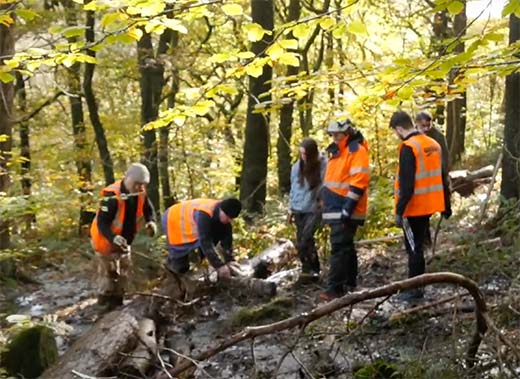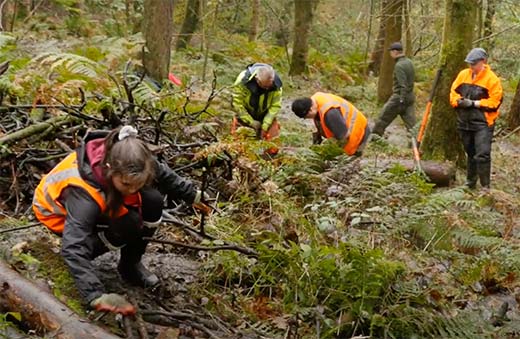Response to Storm Christoph - Slow The Flow
Monday, 25 January 2021
As Storm Christoph moved away from the UK and into Northern Europe, parts of the North West of England and North Wales were feeling the effects of yet another major storm which, due to effects of our changing climate, are becoming more intense and significantly more frequent.
Here in Calderdale, the communities along the Calder Valley have got away with some very frayed nerves and minor disruption on a local level in Walsden and in a small area of Mytholmroyd.
Large capital flood alleviation schemes like the one recently completed in Mytholmroyd, West Yorkshire, are an important part of keeping people safe and making them feel that they have adequate protection from this growing threat. These schemes, though, are very expensive; over £40m in Mytholmroyd. They can also be very intrusive and have a high carbon footprint in their construction. It is also argued that by keeping water in channel, this can push the risk of flood into communities further downstream. The works can be disruptive to the local economy and to the mental, physical and practical wellbeing of residents, not to mention the impact on tourism and on the numbers of visitors who tend to avoid these areas while these works are being carried out.
That being said, Slow The Flow is supportive of traditional 'hard engineering' schemes because they can keep communities safe from rising river levels and make communities feel safer. However, there have been instances where recent schemes have been overtopped.
Notwithstanding the above, we also need to focus on the causes of flooding in our communities, not just treating the effects of flood water, but slowing water reaching these schemes in the first place, thereby reducing the flood peak and hence the possibility of overtopping of our flood defenses. Such approaches also offer a degree of future proofing of existing flood defenses from climate change.

How do we deal with the causes of flooding?
Natural Flood Management (NFM) schemes, like the ones we are currently developing here in Calderdale, offer a tangible and cost-effective additional route to flood alleviation. This includes a catchment-wide, holistic approach to flood management and includes solutions like tree planting, the installation of leaky woody dams and the construction of attenuation storage ponds, all of which can make a significant contribution to reducing flood risk on a local level and reducing the increasing flood risk into populated areas below.
There are, of course, additional benefits like promoting ecological diversity and promoting a sustainable green infrastructure by using these natural processes.
Slow The Flow has developed a number of schemes here in Calderdale. The development of these schemes and the work undertaken to monitor their success can be found here.
We are also delighted that The Environment Agency supports around 60 similar Natural Flood Management pilot schemes around the UK, plus another 40 projects which are within their capital funded program.
There are other organisations around the UK pioneering Natural Flood Management who are also looking at alternative ways of working with natural processes to combat climate change. The Environment Agency have produced lots of very good information on 'Working With Natural Processes' here and it is clear that Natural Flood Management has a major part to play in reducing flood risk.
These schemes are typically cheaper to design, build and implement, as well as providing multiple green infrastructure benefits. They are also usually less intrusive and cause far less disruption to the communities they serve, because NFM will typically be implemented in uninhabited areas of the catchment in the uplands and away from where people live and work.
So why not invest in both on the same scale?

Grants to fund more NFM
Slow The Flow is pleased that the Government have set aside £200m for the Innovative Resilience Scheme announced by Chancellor Rishi Sunak last year. A small amount in comparison to the £5bn offered to 'traditional' schemes like the one in Mytholmroyd. This money will be distributed to 25 areas in the UK to develop NFM and innovative schemes like ours to keep the water from reaching the valleys below.
However, this fund of £200m was originally announced in early 2020 and the process to get it to the communities that need it is still under way. Lead Local Flood Authorities are currently preparing 'expressions of interest' to secure this funding, including our own here in West Yorkshire, but it has simply taken too long to get this money to our communities and for them to start these important programs to deal with the causes of flooding.
More importantly, the funding will not actually get to these communities until later this summer which will result in further delays to these schemes. Natural Flood Management, particularly in the case of attenuation ponds, can only take place in the drier months in the spring and summer when the fields and the uplands are drier. This means that it is likely that the NFM work funded by this grant will not now take place until at least until the Spring of 2022.
Chancellor Rishi Sunak also announced in early 2020 a £5bn fund to spend on large capital flood relief projects like the one in Mytholmroyd. Slow The Flow would like to see this balance redressed and for the Government to increase the spending on innovation and Natural Flood Management because it is far less disruptive to flooded communities and, more importantly, it treats the causes of flooding rather than dealing with the after effects.
Valley communities like ours here in Calderdale, and millions of people around the UK who are at risk of having their homes and businesses disrupted by flooding, need to see more investment, innovation, and value for money. Large, expensive, hard engineering projects are not the only, or indeed the 'best' way, to mitigate this issue. Natural Flood Management has been proven to have multiple benefits as a complementary flood alleviation technique and should see a proportionately greater level of investment.
Let us redress the balance of flood alleviation funding, by investing in the prevention of flooding, not just dealing with the impact once flood water gets into our towns and villages.
See also
Slow The Flow Appoints 'Artist In Residence' - Oct 2020
Slow The Flow - Harnessing the power of nature to reduce flood risk - July 2020
Update from Slow the Flow - March 2020
Slow the Flow - Keeping Natural Flood Management on the agenda - Jan 2020
Slow the Flow win Community Foundation Award - Dec 2019
Slow the Flow project maps local activity to reduce flooding risk - October 2019
Slow The Flow Film and AGM - Feb 2018
Slow the Flow shortlisted as 'Community Group Of The Year' - Oct 2017
Councillor among volunteers helping to Slow the Flow - July 2017
Slow The Flow - Hardcastle Crags - April 2017

